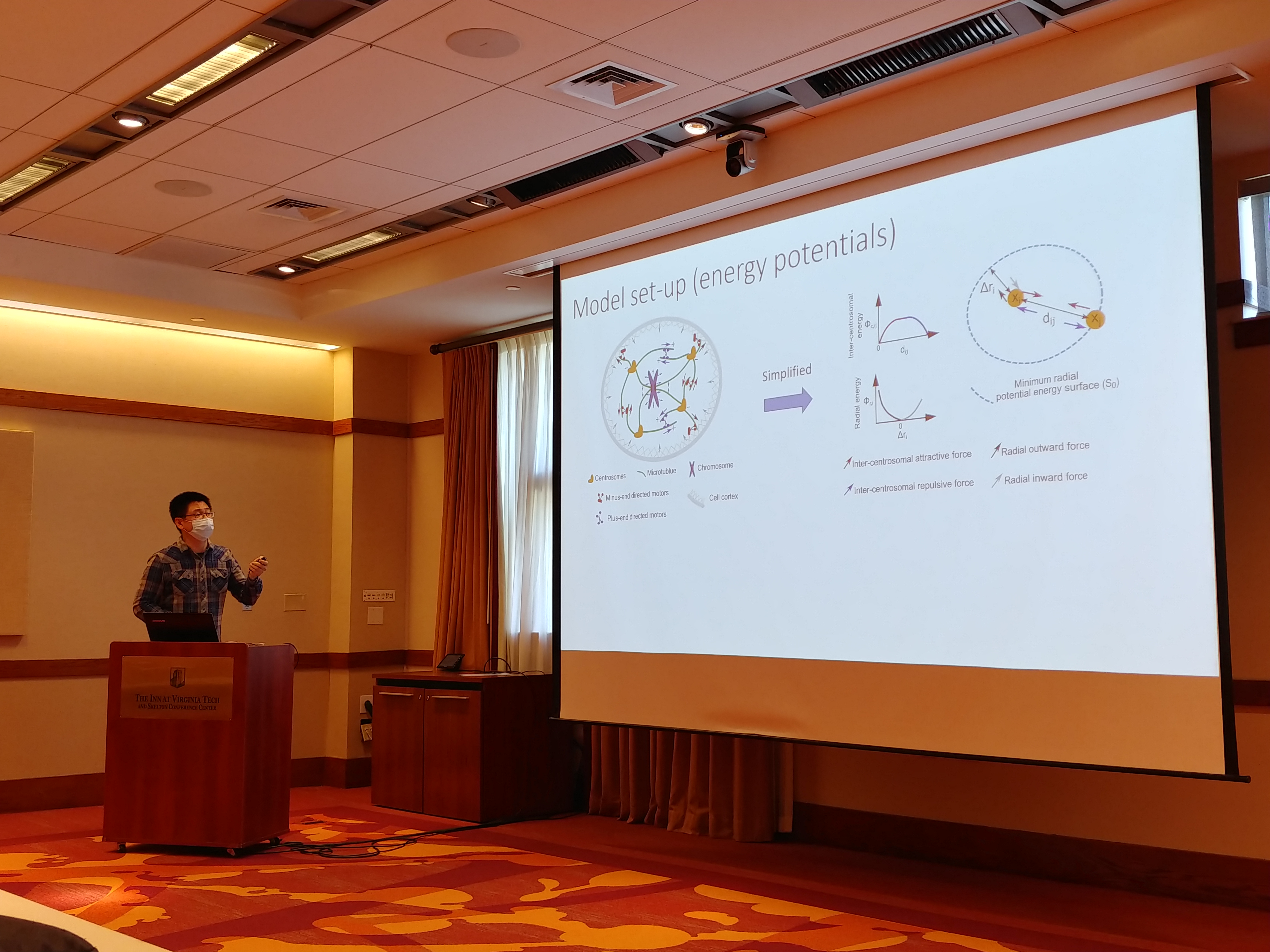News
Sean passed pre-defense!
Sean gave a talk at the Banff International Research Station Emergent Collective Behavior Workshop
Talk title: Mechanical limitation of bacterial motility mediated by growing cell chains.
Yirui gave a GBCB seminar!
Title: Mathematical Modelling of Motility Regulation in Myxococcus xanthus
Abstract: Sensing and responding to mechanical cues in the environment are important for the survival and propagation of bacteria. A ‘social’ bacterium, Myxococcus xanthus, which exhibits periodic cell reversals, modulates its reversal frequency in response to environmental mechanical cues, such as substrate stiffness and cell-cell contact. Here we hypothesize that the gliding motility machinery of M. xanthus can sense the environmental mechanical cues during force generation and modulate the timing and frequency of cell reversal through signaling the cell’s reversal control pathway. To examine our hypothesis, we extend an existing mathematical model for periodic polarity switching (which mediates periodic cell reversal) in M. xanthus, and incorporate the experimentally suggested (i) intracellular dynamics of the gliding motors and (ii) interactions between the gliding motors and reversal regulators. The model results indicate that the experimentally established interaction between the gliding motors and reversal regulators is capable of generating the observed modulations on cell reversal frequency with varied substrate stiffness. Our model prediction also suggests that social twitching motility in wild type M. xanthus is also involved in mediating the mechanosensitive reversal regulation. Furthermore, we propose a reversal control network that qualitatively explains the reversal behaviors in different M. xanthus mutants. In summary, our model highlights a potential role of the gliding machinery of M. xanthus as a ‘mechanosensor’ that transduces mechanical cues into a reversal control signal.
Xiaochu gave a BIOTRANS presentation

Yirui passed prelim!
Xiangyu passed prelim!
Xiaochu passed prelim!
Xiangyu gave a GBCB seminar
Speaker: Xiangyu Yao (Jacky), GBCB Doctoral Candidate
Title: Robustness of Oscillations in Models of the Mammalian Circadian Clock
Abstract: The circadian rhythm aligns bodily functions to the day/night cycle and is important for our health. The rhythm originates from an intracellular, molecular clock mechanism that mediates rhythmic gene expression. It is long understood that transcriptional negative feedback with sufficient time delay is key to generating circadian oscillations. However, some of the most widely cited mathematical models for the circadian clock suffer from problems of parameter ‘fragilities’. That is, sustained oscillations are possible only for physically unrealistic parameter values. A recent model by Kim and Forger nicely incorporates the inhibitory binding of PER2, a key clock protein, to its transcription activator BMAL1, but oscillations in their model require a binding affinity between PER2 and BMAL1 that is orders of magnitude larger than observed binding affinities of protein complexes. To rectify this problem, we make several physiologically credible modifications to the Kim-Forger model, which allow oscillations to occur with more realistic binding affinities. The modified model is further extended to explore the potential roles of supplementary feedback loops in the mammalian clock mechanism. Ultimately, accurate models of the circadian clock will provide better predictive tools for chronotherapy and chrono-pharmacology studies
Sean gave a seminar at the CSMBP
Speaker: Sean McMahon, VT
Date and place: Wednesday, June 21, 4:00-5:00 pm
Title: Mechanical limitations of Clostridium perfringens chains
Abstract: Many bacteria species are able to expedite colony expansion through motility of the cells. Clostridium perfringens, the primary cause of lethal gas gangrene, exhibits a unique mode of colony expansion on a substrate surface that, surprisingly, does not depend on motility in single cells. Specifically, daughter cells maintain end-to-end connections after cell division, amounting to long chains of cells that continuously elongate as individual cells grow and divide. Such cell growth-driven motility would accelerate as cell divisions increase the number of cells in a chain, and the tip of a long chain could potentially reach a very high speed. However, in this work we constructed a mechanical model to show that the efficacy of such growth-driven motility is limited by the buildup of mechanical stresses at the cell-cell joints. Specifically, our model depicts the growth of the bacterial chains based on the cell growth, strength of connections between cells, and drag forces from the substrate. Our model shows that stress at the joints between adjacent cells increases exponentially as the cell chain grows, making long chains prone to breakage. We further performed a perturbation analysis to estimate the critical stress leading to chain breakage and its dependence on the mechanical attributes and cell growth rate. Based on this critical breaking stress, we were able to estimate the physical limits of the elongation rate of a single cell chain, and found it to fall short of the rate at which wild C. perfringens can penetrate patient tissues. Finally, the model suggests additional mechanisms that can help C. perfringens chains delay breakage and thereby achieve a higher expansion rate.